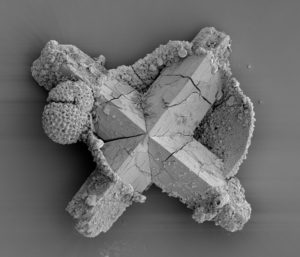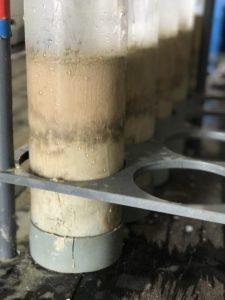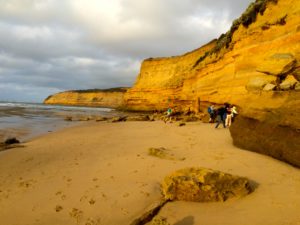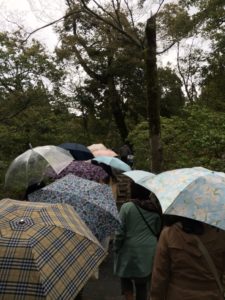Projects
Overview
What controls the long-term trajectory of Earth’s climate and ocean chemistry? How do marine sediments regulate – and bear witness to – these changes? My research investigates the diverse and dynamic subseafloor geochemical processes actively interacting with the ocean and long-term changes in climate. Focused around deciphering marine sediment, my approach adapts to the scientific question and incorporates a variety of organic and inorganic isotope systems, compound-specific biomarkers, and advanced multivariate statistical modeling of major, trace, and rare earth element concentrations. Here I describe a few of my past or ongoing projects.

Reverse Weathering and Paleoclimate
While there is strong evidence that atmospheric CO2 decreased and the Earth cooled over the past 50 million years, the mechanism driving this trend is still not well understood. A few hypotheses invoke an increase in silicate weathering, changes in weatherability, and/or a decline in volcanic outgassing. In a recent study, we propose a novel hypothesis suggesting that a decrease in the global rate of clay mineral formation on or in the seafloor (i.e., reverse weathering) could cause the same trend. Using magnesium isotopes and element concentrations combined with multivariate statistics, we fingerprint the geochemical signature of newly formed clay and show how changes in reverse weathering could be largely responsible for the increase in seawater Mg/Ca and the global cooling observed over the past 50 million years.
Related Publication
- Dunlea, A. G., R. W. Murray, D. P. Santiago Ramos, and J. A. Higgins (2017) Cenozoic global cooling and increased seawater Mg/Ca via reduced reverse weathering. Nature Communications, 8, doi:10.1038/s41467-017-00853-5

Seawater-Sediment Element Cycling
Photosynthesis in the Southern Ocean consumes a massive amount of atmospheric CO2, but the magnitude is limited by the availability of certain trace metals (e.g., iron, cobalt, or other) in surface waters. Water column research shows that cobalt has a relatively short ocean residence time (~40-150 years) and is not well mixed in the ocean. On the contrary, studies of clays in the deep open-ocean suggest the deposition of cobalt from the water column is broadly constant through time and space. By uniting perspectives from water column and sediment research, we examine the cycling of metals in the ocean and seafloor and how they have changed through time.
Related Publication
- Dunlea, A. G.*, L. A. Tegler*, B. Peucker-Ehrenbrink, A. D. Anbar, S. J. Romaniello, T. J. Horner, (2021) Pelagic clays as archives of marine iron-isotope chemistry. Chemical Geology, 575, 12020. doi: 10.1016/j.chemgeo.2021.120201
*First and second authors contributed equally.
- Dunlea, A. G., R. W. Murray, J. Sauvage, R. A. Pockalny, A. J. Spivack, R. N. Harris, and S. D’Hondt (2015) Cobalt-based age models of pelagic clay in the South Pacific Gyre. Geochemistry, Geophysics, Geosystems, 16, 2694-2710. doi: 10.1002/2015GC005892

Dust and the Desertification of Australia
Dust and volcanic ash can play a critical role in the climate system by changing surface/planetary albedo, acting as cloud condensation nuclei, and enhancing biological productivity in certain ocean regions. Over the past 65 million years, Australia aridified and became the largest source of dust in the Southern Hemisphere. My doctoral research used element concentrations and multivariate statistical modeling to “unmix” and quantify the fluxes of six components of pelagic clay including dust, two types of volcanic ash, Fe/Mn-oxyhydroxides, apatite and excess Si. Combined with an age model, we quantified the distal transport of dust and volcanic ash to the South Pacific Gyre as Australia desertified.
Related Publication
- Dunlea, A. G., R. W. Murray, J. Sauvage, A. J. Spivack, R. N. Harris, and S. D’Hondt (2015) Dust, volcanic ash, and the evolution of the South Pacific Gyre through the Cenozoic. Paleoceanography, 30, 1078-1099. doi: 10.1002/2015PA002829

Monsoon Variability
Over one half of the global population is directly dependent on monsoonal rains for their immediate source of water. To better understand how monsoon systems will vary in the future, we examine precipitation and vegetation patterns in the past. In 2016, I joined an international community of scientists studying global monsoon systems when I sailed on IODP Exp. 346 focused on the East Asian Monsoon. My monsoon work expanded during my postdoctoral research with L. Giosan (WHOI) and Y. Huang (Brown Univ.) to examine how the Indian Monsoon rains drive vegetation patterns over the past 6 million years, which we reconstructed with compound-specific biomarkers (e.g., δ13C and δD of fatty acids from leaf waxes, alkanes, alkenones).
Related Publications
- Dunlea, A. G., L. Giosan, Y. Huang (2020) Pliocene expansion of C4 vegetation in the core monsoon zone on the Indian Peninsula. Climates of the Past, 16, 1-14. doi: 10.5194/cp-16-1-2020
- Anderson, C. H., R. W. Murray, A. G. Dunlea, L. Giosan, C. W. Kinsley, D. McGee, and R. Tada (2018) Climatically driven changes in the supply of terrigenous sediment to the East China Sea. Geochemistry, Geophysics, Geosystems, accepted. doi: 10.1029/2017GC007339
- Tada, R., T. Irino, K. Ikehara, A. Karasuda, S. Sugisaki, C. Xuan, T. Sagawa, T. Itaki, Y. Kubota, S. Lu, A. Seki, R. W. Murray, C. A. Alvarez Zarikian; W. T. Anderson, M. Bassetti, B. J. Brace, S. C. Clemens, M. H. da Costa Gurgel, G. R. Dickens, A. G. Dunlea, S. J. Gallagher, L. Giosan, A. C. G. Henderson, A. E. Holbourn, C. W. Kinsley, G. Soo Lee, K. E. Lee, J. Lofi, C. I.C.D. Lopes, M. Saavedra Pellitero, L. C. Peterson, R. K. Singh, S. Toucanne, S. Wan, H. Zheng, M. Ziegler (2018) High-resolution and -precision correlation of dark and light layers in the Quaternary hemipelagic sediments of the Japan Sea recovered during IODP Expedition 346. Progress in Earth and Planetary Science, 5, doi: 10.1186/s40645-018-0167-8
- Tada, R., R. W. Murray, C. A. Alvarez Zarikian, and the Expedition 346 Scientists (2015) Proceedings of the Integrated Ocean Drilling Program, 346, College Station, TX, doi:10.2204/iodp.proc.346.2015
- Expedition 346 Scientists (2013) Asian Monsoon: onset and evolution of millennial-scale variability of Asian monsoon and its possible relation with Himalaya and Tibetan Plateau uplift. Integrated Ocean Drilling Program Preliminary Reports, 346, doi:10.2204/iodp.pr.346.2014